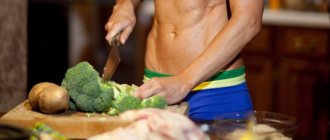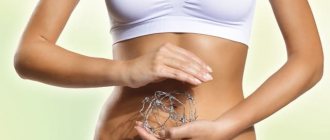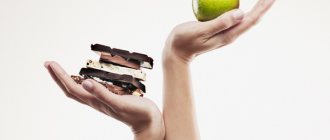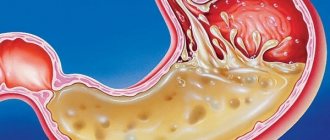11/25/2019 Article
- general characteristics
- Table "Do's and Don'ts"
- Menu for the week
- Diet "Table 2A"
Indications for prescribing the “2 table” diet are:
- chronic gastritis with secretory insufficiency with mild exacerbation and in the recovery stage after exacerbation;
- acute gastritis, enteritis, colitis during the recovery period, the diet is used as a transition to a balanced diet;
- chronic enteritis and colitis after and without exacerbation and without concomitant diseases of the liver, biliary tract, pancreas or gastritis with preserved or increased secretion.
The diet is also prescribed during the recovery period after acute infections and operations.
General rules
Medical nutrition or “medicinal table” is prescribed for various diseases. Table No. 2 of the Pevzner diet is designed primarily for patients suffering from chronic gastritis with secretory insufficiency and is recommended for mild exacerbations or during the recovery period.
In addition, it is indicated for patients after acute gastritis , colitis and enteritis as a transition to normal nutrition. It can also be followed by patients with chronic colitis in the absence of exacerbation and concomitant gastrointestinal diseases.
It should be noted that the 2nd therapeutic diet is a physiologically complete diet with moderate sparing of the gastrointestinal tract and stimulation of organ secretion. In addition, it normalizes the motor function of the digestive organs. Since the main purpose of its purpose is to stimulate secretion, dishes of varying degrees of grinding and processing are included. These can be boiled and stewed dishes, baked and even fried, but without a rough crust (therefore, breading in flour and breadcrumbs is not allowed).
Dishes are practically not pureed, and only products rich in fiber (coarse vegetables) or connective tissue (stringy meat) can be pureed.
However, foods that are difficult to digest and linger in the stomach for a long time, thereby irritating the mucous membrane, as well as very cold and very hot dishes are excluded. According to its chemical composition, it is distinguished by its completeness: 100 g of proteins, 100 g of fats and up to 420 g of carbohydrates. Daily calorie content: 3000 kcal. Food is taken in equal portions.
We can summarize the main points of the therapeutic diet:
- introduction of secretion agents into the diet (broths);
- pureeing dishes is not necessary - fine chopping of boiled vegetables for second courses and fresh ones for first courses is allowed;
- exclusion of difficult to digest foods;
- food processing capabilities have been expanded (frying is allowed);
- Excessively cold and hot dishes are excluded;
- salt is moderately limited;
- 4-5 meals a day are provided, including drinking kefir before bed;
- daily ration by weight should not exceed 3 kg;
- The norm for liquid is 7 glasses a day, but you can’t drink it with meals.
Main characteristics of the diet
Table 2 according to Pevzner refers to “gentle” diets, the purpose of which is to reduce the functional load on the organs of the gastrointestinal tract with mild stimulation of the glands that produce gastric juice and digestive enzymes. It includes several main key characteristics:
- Limiting foods in the diet that lead to a slowdown in peristalsis (“wave-like” movements of the walls of the hollow organs of the gastrointestinal tract, due to which the contents are pushed into the lower sections) of the stomach and small intestine.
- Moderate reduction in mechanical and chemical irritation of the mucous membrane of the hollow structures of the digestive system.
- Slight stimulation of the activity of the digestive glands, as well as the parietal cells of the gastric mucosa, which are responsible for the production of hydrochloric acid.
- Normalization of the functional state and tone of the muscle layer of the walls of the hollow organs of the digestive system.
- Sufficient energy value of food, as well as the presence of essential amino acids and vitamins in the diet.
Dietary recommendations imply the use of a fairly wide range of permitted products, as well as various cooking methods. In terms of composition, daily quantity and volumetric ratio of the main classes of compounds, diet 2 includes:
- Proteins – 100 g, of which most (60%) should include compounds of animal origin.
- Carbohydrates – 400-500 g, almost all of them should be of plant origin with a sufficient amount of fiber.
- Fats – 90-100 g, of which 25% of lipids should be of plant origin.
- Water – 1.5 l.
- Table salt (sodium chloride) – up to 15 g.
- Energy value – 2800-3000 kcal.
To reduce the functional load on the digestive system, it is recommended to eat 5 times in small portions.
Authorized Products
Soups are prepared in a weak broth (meat/fish/mushroom) with the addition of finely chopped vegetables, well-cooked cereals, noodles, and you can add meatballs. If tolerated, borscht, cabbage soup and beetroot soup are allowed, but the vegetables need to be chopped very finely. Rassolnik is prepared with vegetables, but without pickles (brine is used instead).
Main courses are prepared from lean meat without tendons. For this they use beef, lamb, pork, chicken and turkey, tongue, and liver. You can use them to make cutlets, dumplings, meatballs, zrazy; all these products can not only be baked, but also fried without breading, simply brushed with egg. Veal, chicken and rabbit can be cooked in pieces.
Pancakes with boiled meat are allowed, but they must be baked. You need to choose low-fat varieties of fish that can be baked, stewed or fried without breading, and make products from fish mass. Soaked herring is allowed; it can be consumed in the form of mincemeat or herring oil.
All cereals are added to garnishes and soups, except coarse ones: pearl barley and millet; vermicelli; noodles. Porridge can be cooked in broth or water and boil well. Souffles, puddings and cutlets are made from cereals (can be fried without a rough crust). Casseroles with vermicelli (noodles) and cottage cheese (meat), and fruit pilaf are allowed. Wheat bread is allowed only stale or dried. You can eat biscuits or biscuits. Twice a week - baked savory pies with apples, jam or cottage cheese.
Dairy products allowed are yogurt, kefir, cottage cheese and sour cream. You can make souffles, lazy dumplings, cheesecakes, and puddings from cottage cheese. Pieces and grated cheese are allowed, 2 eggs twice a week (soft-boiled, omelet with cheese and fried eggs without crust). Milk and cream are added only to dishes.
Among the appetizers on a fresh table, you can allow a salad of boiled vegetables, boiled meat and fish, liver pate, doctor's or milk sausage, jellied fish in a vegetable broth, lean herring, sturgeon caviar and lean ham.
Allowed: potatoes, carrots, zucchini, pumpkin, beets, cauliflower. If tolerated well, green peas and white cabbage are administered. They can be boiled, stewed, baked in pieces, added to casseroles and made into vegetable cutlets, but lightly fried. You can add a little bay leaf, parsley, dill or celery to stewed vegetables. Fresh ripe tomatoes are also allowed. You can make salads from tomatoes with vegetable oil (exclude onions, sweet peppers and cucumbers). Salads of boiled vegetables with meat and eggs (without onions, sauerkraut and pickles).
Ripe fruits and berries, not pureed, are allowed if they are very soft or pureed. If well tolerated - up to 100-200 g of tangerines, oranges, watermelon, grapes without skin. Baked apples. From fruits you can make purees, jelly, jellies, compotes, add oranges and lemons to tea. Meringues, butter caramel, toffee, marmalade, marshmallows, marshmallows, jam, and honey are allowed as desserts. Drinks include fruit juices, tea with lemon, rosehip infusion.
Table of permitted products
| Proteins, g | Fats, g | Carbohydrates, g | Calories, kcal | |
Vegetables and greens | ||||
| zucchini | 0,6 | 0,3 | 4,6 | 24 |
| cauliflower | 2,5 | 0,3 | 5,4 | 30 |
| potato | 2,0 | 0,4 | 18,1 | 80 |
| carrot | 1,3 | 0,1 | 6,9 | 32 |
| beet | 1,5 | 0,1 | 8,8 | 40 |
| tomatoes | 0,6 | 0,2 | 4,2 | 20 |
| pumpkin | 1,3 | 0,3 | 7,7 | 28 |
Fruits | ||||
| apricots | 0,9 | 0,1 | 10,8 | 41 |
| watermelon | 0,6 | 0,1 | 5,8 | 25 |
| bananas | 1,5 | 0,2 | 21,8 | 95 |
| melon | 0,6 | 0,3 | 7,4 | 33 |
| nectarine | 0,9 | 0,2 | 11,8 | 48 |
| peaches | 0,9 | 0,1 | 11,3 | 46 |
| apples | 0,4 | 0,4 | 9,8 | 47 |
Berries | ||||
| strawberry | 0,8 | 0,4 | 7,5 | 41 |
Cereals and porridges | ||||
| buckwheat (kernel) | 12,6 | 3,3 | 62,1 | 313 |
| semolina | 10,3 | 1,0 | 73,3 | 328 |
| cereals | 11,9 | 7,2 | 69,3 | 366 |
| white rice | 6,7 | 0,7 | 78,9 | 344 |
Bakery products | ||||
| white bread crackers | 11,2 | 1,4 | 72,2 | 331 |
Confectionery | ||||
| jam | 0,3 | 0,2 | 63,0 | 263 |
| jelly | 2,7 | 0,0 | 17,9 | 79 |
| marshmallows | 0,8 | 0,0 | 78,5 | 304 |
| milk candies | 2,7 | 4,3 | 82,3 | 364 |
| fondant candies | 2,2 | 4,6 | 83,6 | 369 |
| fruit and berry marmalade | 0,4 | 0,0 | 76,6 | 293 |
| meringues | 2,6 | 20,8 | 60,5 | 440 |
| paste | 0,5 | 0,0 | 80,8 | 310 |
| Maria cookies | 8,7 | 8,8 | 70,9 | 400 |
Raw materials and seasonings | ||||
| honey | 0,8 | 0,0 | 81,5 | 329 |
| sugar | 0,0 | 0,0 | 99,7 | 398 |
| milk sauce | 2,0 | 7,1 | 5,2 | 84 |
Dairy | ||||
| milk | 3,2 | 3,6 | 4,8 | 64 |
| kefir | 3,4 | 2,0 | 4,7 | 51 |
| cream | 2,8 | 20,0 | 3,7 | 205 |
| sour cream | 2,8 | 20,0 | 3,2 | 206 |
| curdled milk | 2,9 | 2,5 | 4,1 | 53 |
| acidophilus | 2,8 | 3,2 | 3,8 | 57 |
| yogurt | 4,3 | 2,0 | 6,2 | 60 |
Cheeses and cottage cheese | ||||
| cottage cheese | 17,2 | 5,0 | 1,8 | 121 |
Meat products | ||||
| boiled beef | 25,8 | 16,8 | 0,0 | 254 |
| beef liver | 17,4 | 3,1 | 0,0 | 98 |
| boiled beef tongue | 23,9 | 15,0 | 0,0 | 231 |
| boiled veal | 30,7 | 0,9 | 0,0 | 131 |
| rabbit | 21,0 | 8,0 | 0,0 | 156 |
Bird | ||||
| boiled chicken | 25,2 | 7,4 | 0,0 | 170 |
| turkey | 19,2 | 0,7 | 0,0 | 84 |
Eggs | ||||
| chicken eggs | 12,7 | 10,9 | 0,7 | 157 |
Fish and seafood | ||||
| black caviar | 28,0 | 9,7 | 0,0 | 203 |
| salmon caviar granular | 32,0 | 15,0 | 0,0 | 263 |
| herring | 16,3 | 10,7 | — | 161 |
Oils and fats | ||||
| butter | 0,5 | 82,5 | 0,8 | 748 |
| corn oil | 0,0 | 99,9 | 0,0 | 899 |
| olive oil | 0,0 | 99,8 | 0,0 | 898 |
| sunflower oil | 0,0 | 99,9 | 0,0 | 899 |
| ghee | 0,2 | 99,0 | 0,0 | 892 |
Non-alcoholic drinks | ||||
| mineral water | 0,0 | 0,0 | 0,0 | — |
| coffee with milk and sugar | 0,7 | 1,0 | 11,2 | 58 |
| black tea with milk and sugar | 0,7 | 0,8 | 8,2 | 43 |
Juices and compotes | ||||
| apricot juice | 0,9 | 0,1 | 9,0 | 38 |
| carrot juice | 1,1 | 0,1 | 6,4 | 28 |
| pumpkin juice | 0,0 | 0,0 | 9,0 | 38 |
| * data is per 100 g of product | ||||
Diet table number 2 – recipes
Tomatoes with green salad.
Ingredients: 10 g olive oil, 20 g green salad, 100 g tomatoes. Finely chop the peeled tomatoes. Wash the green lettuce thoroughly, chop it finely and mix with the tomatoes. Place in a salad bowl and season with olive oil.
Cucumbers with dill and sour cream.
Ingredients: 20 g sour cream, 10 g dill, 100 g cucumbers. Peel fresh cucumbers, chop them finely and mix with pre-prepared dill. After adding a small amount of salt, season with sour cream.
Rice porridge with raisins and dried apricots.
Ingredients: 5 g butter, 20 g raisins, 20 g dried apricots, 60 ml water, 100 ml milk, 50 g rice. Wash the raisins, dried apricots and rice, pour into boiling water, add sugar and salt, cook for ten minutes. Then add milk and cook over low heat until done. Serve with butter.
Lapshevnik baked with cheese.
Ingredients: 5 g sour cream, 20 g mild cheese, 1-4 eggs, 5 g granulated sugar, 5 g butter, 350 ml water, 60 g noodles. Pour the noodles into salted boiling water, cook, place in a colander, and let the water drain. After this, add grated cheese, egg, sugar, butter, mix well and place on a baking sheet greased with vegetable oil. Spread sour cream on top and bake in the oven.
Author of the article:
Kuzmina Vera Valerievna |
Endocrinologist, nutritionist Education: Diploma of the Russian State Medical University named after. N.I. Pirogov, specialty “General Medicine” (2004). Residency at the Moscow State Medical and Dental University, diploma in Endocrinology (2006). Our authors
Fully or partially limited products
It is expected to exclude vegetables rich in fiber (radish, turnip, beans, peas, white cabbage, rutabaga) and foods with connective tissue (cartilage, veins, skin). You should not eat milk soups, pea soups, those with added millet, bean soups, or okroshka. Duck and goose meat and lamb should be excluded from meat products. Sorrel, spinach, onions, cucumbers, and sweet peppers are also excluded from vegetables and herbs. Allowed vegetables (tomato coma) should not be consumed raw. Pickled and pickled vegetables are not allowed.
You should not eat fatty fish or canned fish. It should be taken into account that hard-boiled eggs are poorly digestible, so they are excluded in this form. Pork lard, cooking and animal fats, as well as hot seasonings for dishes (hot sauces, horseradish, mustard, garlic, pepper) are prohibited. Any fresh bread, butter or puff pastry is prohibited. As for desserts, it is not allowed to consume dried fruits, berries with grains (raspberries, currants), rough skins (gooseberries, grapes), grape juice, chocolate and ice cream, dates, figs, kvass.
Millet, pearl barley, barley and corn cereals are limited because they are difficult to digest, as well as fatty pork. Milk and cream are consumed with restrictions, adding only to dishes, water porridges, tea and coffee.
Table of prohibited products
| Proteins, g | Fats, g | Carbohydrates, g | Calories, kcal | |
Vegetables and greens | ||||
| vegetables legumes | 9,1 | 1,6 | 27,0 | 168 |
| swede | 1,2 | 0,1 | 7,7 | 37 |
| cabbage | 1,8 | 0,1 | 4,7 | 27 |
| sauerkraut | 1,8 | 0,1 | 4,4 | 19 |
| green onion | 1,3 | 0,0 | 4,6 | 19 |
| bulb onions | 1,4 | 0,0 | 10,4 | 41 |
| cucumbers | 0,8 | 0,1 | 2,8 | 15 |
| canned cucumbers | 2,8 | 0,0 | 1,3 | 16 |
| salad pepper | 1,3 | 0,0 | 5,3 | 27 |
| white radish | 1,4 | 0,0 | 4,1 | 21 |
| turnip | 1,5 | 0,1 | 6,2 | 30 |
| canned tomatoes | 1,1 | 0,1 | 3,5 | 20 |
| horseradish | 3,2 | 0,4 | 10,5 | 56 |
| spinach | 2,9 | 0,3 | 2,0 | 22 |
| sorrel | 1,5 | 0,3 | 2,9 | 19 |
Fruits | ||||
| figs | 0,7 | 0,2 | 13,7 | 49 |
Berries | ||||
| grape | 0,6 | 0,2 | 16,8 | 65 |
| gooseberry | 0,7 | 0,2 | 12,0 | 43 |
| raspberries | 0,8 | 0,5 | 8,3 | 46 |
| Red currants | 0,6 | 0,2 | 7,7 | 43 |
Mushrooms | ||||
| mushrooms | 3,5 | 2,0 | 2,5 | 30 |
Nuts and dried fruits | ||||
| dates | 2,5 | 0,5 | 69,2 | 274 |
Cereals and porridges | ||||
| corn grits | 8,3 | 1,2 | 75,0 | 337 |
| pearl barley | 9,3 | 1,1 | 73,7 | 320 |
| millet cereal | 11,5 | 3,3 | 69,3 | 348 |
| barley grits | 10,4 | 1,3 | 66,3 | 324 |
Ice cream | ||||
| ice cream | 3,7 | 6,9 | 22,1 | 189 |
Chocolate | ||||
| chocolate | 5,4 | 35,3 | 56,5 | 544 |
Raw materials and seasonings | ||||
| mustard | 5,7 | 6,4 | 22,0 | 162 |
| ginger | 1,8 | 0,8 | 15,8 | 80 |
| ketchup | 1,8 | 1,0 | 22,2 | 93 |
| mayonnaise | 2,4 | 67,0 | 3,9 | 627 |
| ground black pepper | 10,4 | 3,3 | 38,7 | 251 |
Meat products | ||||
| pork | 16,0 | 21,6 | 0,0 | 259 |
| salo | 2,4 | 89,0 | 0,0 | 797 |
Bird | ||||
| smoked chicken | 27,5 | 8,2 | 0,0 | 184 |
| duck | 16,5 | 61,2 | 0,0 | 346 |
| smoked duck | 19,0 | 28,4 | 0,0 | 337 |
| goose | 16,1 | 33,3 | 0,0 | 364 |
Fish and seafood | ||||
| dried fish | 17,5 | 4,6 | 0,0 | 139 |
| smoked fish | 26,8 | 9,9 | 0,0 | 196 |
| canned fish | 17,5 | 2,0 | 0,0 | 88 |
Oils and fats | ||||
| animal fat | 0,0 | 99,7 | 0,0 | 897 |
| cooking fat | 0,0 | 99,7 | 0,0 | 897 |
Non-alcoholic drinks | ||||
| bread kvass | 0,2 | 0,0 | 5,2 | 27 |
| * data is per 100 g of product | ||||
Diet menu No. 2
Now that we have found out the foods allowed in this therapeutic diet and the main methods of preparing them, we can create a one-day diet menu for the 2nd table, and using it as a basis, develop nutrition for the whole week. Since the list of products is quite wide and the possibilities for their processing have been expanded, nutrition should be complete and varied. It is allowed to add bay leaves and herbs to dishes.
| Breakfast |
|
| Dinner |
|
| Afternoon snack |
|
| Dinner |
|
| For the night |
|
Other variations
There are variations of the technique.
Diet number 2 - this option differs from the others in its strictness: you cannot violate the prescribed diet, junk food is prohibited.
The program is prescribed for serious diseases of the digestive system , when the patient’s condition is serious. This could be acute gastritis (read about nutrition during exacerbation of the disease here), colitis, liver disease.
The basic rule is that you should not give the patient hard, too cold or hot food . Food should be easy to digest. For this reason, the menu contains a lot of purees, soups, and broths.
The menu contains products that create healthy microflora and are easily digestible.
Harmful bacteria are killed and the progression of the disease can be stopped. The man is on the mend.
No. 2A
This program is prescribed during a period of stable remission of chronic diseases of the digestive system, when a person feels better and symptoms of the disease do not appear. The patient's condition is assessed as satisfactory. He feels no pain in his stomach and feels great.
Diet is needed to maintain good condition . It is not strict; almost all foods are allowed, but with the exception of those that are too spicy and fatty. The menu is very varied, there are not only vegetable and fruit dishes, but also sweets, pork, and lamb.
You can eat solid food, it does not have to be mashed. Purees and soups are not prepared every day, upon request.
Advantages and disadvantages
| pros | Minuses |
|
|
Indications
There are several medical indications on the basis of which a specialist gastroenterologist, internist, pediatrician or family doctor prescribe diet 2, these include:
- Acute gastritis (inflammation of the stomach), enteritis (inflammation of the small intestine) or colitis (inflammation of the colon) at the stage of gradual restoration of the functional state of the digestive system, as well as a decrease in the severity of pathological changes. Diet 2 is prescribed for the purpose of a smooth transition to normal nutrition.
- Chronic enteritis or colitis, which has an isolated long-term course of more than six months and is not accompanied by inflammation of the liver tissue (hepatitis), structures of the hepatobiliary system (cholecystitis, cholangitis), as well as the stomach with a concomitant increase in secretion and acidity.
- Chronic gastritis, in which the functional and secretory activity of the stomach is characterized by a slight decrease. The diet is usually prescribed at the stage of exacerbation of the pathological process.
The use of dietary recommendations is justified to prevent the development and manifestation of pathological conditions, as well as to prevent exacerbation (relapse) of chronic pathology.
Reviews and results
Medical nutrition does not mean monotony and tastelessness of dishes. You can diversify it with new dishes - just don’t be lazy and do everything to restore your health. Reviews from patients indicate that this diet has a beneficial effect on the gastrointestinal tract. Already in the first week, pain and discomfort in the stomach decrease, belching and heartburn disappear.
- “... For gastritis, table number 2 is prescribed, the diet completely suits me! There is a point in therapeutic nutrition, and I tested this on myself, since if it is violated, discomfort in the stomach, belching and even diarrhea immediately appear. It’s especially hard after holidays and heavy food”;
- “... I like it, I eat this way almost all the time, at least I try. I got rid of the unpleasant heaviness in the stomach, the bloating disappeared. I started cooking for myself separately, and then the whole family joined. The son said that now he has no stomach discomfort or belching”;
- “... In the spring, when gastritis worsens, you have to seriously take care of your diet. I love spicy foods, so it’s hard for me to tolerate food restrictions, but I have to. I can withstand a maximum of 3 weeks, but even during this time I feel a significant improvement. If it weren’t for my passion for spicy and smoked foods, I think I wouldn’t have suffered from gastritis”;
- “... It’s hard for me to bear it, and it’s even harder to cook for myself separately - I don’t have time. I think it is suitable for retirees or housewives - they have time to cook. Therefore, I can withstand it for 2 weeks, and then retreats begin and the transition to a common table begins. In winter, when there are few berries and fruits, it is especially difficult to organize snacks for yourself - you can only bake apples and carry jars with you to work. Inconvenient."
For what diseases is it prescribed?
General indications for using the diet:
- Gastritis (learn about nutrition for this disease here).
- Colitis (read about the features of a therapeutic diet for colitis here).
- Enteritis.
- Liver diseases (about the diet for such diseases - in this article).
- Diseases of the biliary tract.
The technique allows you to reduce the load on the digestive organs and helps to activate the secretory activity of the stomach.
If the patient had excess fat, it disappears. Metabolism is normalized and the development of diseases is stopped.
The person’s condition improves significantly: abdominal pain, flatulence, and bloating disappear. It is possible to create a healthy microflora in the organs.
Foods that are allowed to be consumed saturate the body with vitamins and minerals, thereby strengthening it.
Improvement occurs, the person gains more strength and energy. Efficiency increases, weakness and drowsiness disappear. Even the complexion becomes healthy: pallor disappears, instead a blush appears.











